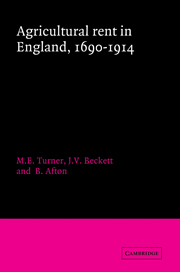Book contents
- Frontmatter
- Contents
- List of figures
- List of tables
- Preface
- Note on the text
- List of abbreviations
- Two examples of contemporary rent books
- Introduction
- 1 Agricultural rent in England
- 2 Contemporary views of rent in eighteenth and nineteenth-century England
- 3 The current state of knowledge
- 4 The determining parameters of a rent index
- 5 Constructing the rent index I: estate records
- 6 Constructing the rent index II: government inquiries
- 7 Constructing the rent index III: other studies
- 8 An English agricultural rent index, 1690–1914
- 9 Rent arrears and regional variations
- 10 The rent index and agricultural history I: the long term
- 11 The rent index and agricultural history II: the short term
- Conclusion
- Appendix 1 Sources of the rent index
- Appendix 2 Statistical summary
- Bibliography
- Index
4 - The determining parameters of a rent index
Published online by Cambridge University Press: 02 December 2009
- Frontmatter
- Contents
- List of figures
- List of tables
- Preface
- Note on the text
- List of abbreviations
- Two examples of contemporary rent books
- Introduction
- 1 Agricultural rent in England
- 2 Contemporary views of rent in eighteenth and nineteenth-century England
- 3 The current state of knowledge
- 4 The determining parameters of a rent index
- 5 Constructing the rent index I: estate records
- 6 Constructing the rent index II: government inquiries
- 7 Constructing the rent index III: other studies
- 8 An English agricultural rent index, 1690–1914
- 9 Rent arrears and regional variations
- 10 The rent index and agricultural history I: the long term
- 11 The rent index and agricultural history II: the short term
- Conclusion
- Appendix 1 Sources of the rent index
- Appendix 2 Statistical summary
- Bibliography
- Index
Summary
We have argued in the preceding chapters that the existing state of knowledge allows us to understand the broad pattern of rent movement in England without providing a systematically compiled and rationally constructed index. Yet the data to do the job properly are available in a manner and form denied to contemporaries. Whereas reporters to the Board of Agriculture found farmers reluctant to discuss their rents, and presumably neither inquired after estate accounts nor would have been granted access to them if they had asked, the material is widely available to us today. The opening up of archives through the deposit of estate papers in public repositories, has provided a vast range of documentation which historians have not been slow to exploit. Over the past several decades a great number of estate biographies have been compiled, and from some of these we are able to extract useful rental material (chapter 7). In addition, contemporary commentators had no access to the wealth of material made available to the Royal Commission on agriculture in the 1890s, which collected rental material in a methodical way. In chapters 5–7 we shall discuss in some detail the material available and how we have used it to construct a rent index, but first we examine the different ways in which such an index might be constructed, in order to determine why we have proceeded in the manner outlined in subsequent chapters.
Almost certainly there is no such thing as an ideal rent index, although it is possible to think of ways to create an index which is ideal for certain purposes.
- Type
- Chapter
- Information
- Agricultural Rent in England, 1690–1914 , pp. 70 - 84Publisher: Cambridge University PressPrint publication year: 1997

